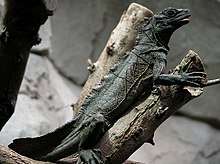Hydrosaurus
Hydrosaurus, commonly known as the sailfin lizards, is a genus in the family Agamidae.[2] These relatively large lizards are named after the sail-like structure on their tails. They are native to the Philippines, Indonesia and Papua New Guinea, where they are generally found near water, such as rivers and mangrove.[3] Sailfin lizards are semiaquatic and able to run short distances across water using both their feet and tail for support, similar to the basilisks.[4] They are threatened by both habitat loss and overcollection for the wild animal trade.[3]
| Sailfin lizards | |
|---|---|
 | |
| Hydrosaurus amboinensis | |
| Scientific classification | |
| Kingdom: | Animalia |
| Phylum: | Chordata |
| Class: | Reptilia |
| Order: | Squamata |
| Suborder: | Iguania |
| Family: | Agamidae |
| Subfamily: | Hydrosaurinae |
| Genus: | Hydrosaurus Kaup, 1828[1] |
| Species | |
|
See text | |
They are the only members of the subfamily Hydrosaurinae.
Species
There are currently five valid species according to the Reptile Database,[2][3][5]
- Hydrosaurus amboinensis (Schlosser, 1768) – Amboina sailfin lizard or Amboina sail-finned lizard
- Hydrosaurus celebensis (Peters, 1872) – Sulawesi sailfin lizard
- Hydrosaurus microlophus (Bleeker, 1860) – Makassar sailfin lizard
- Hydrosaurus pustulatus (Eschsholtz, 1829) – Philippine sailfin lizard, crested lizard, sail-fin lizard, sailfin water lizard, or soa-soa water lizard[6]
- Hydrosaurus weberi Barbour, 1911 – Weber's sailfin lizard
gollark: Why do your pictures also include your roömmate? This is an obvious privacy violation.
gollark: I mean, the explanation I heard was more that degrees are more for signalling that you have some level of ability to do basic intellectual work, and do moderately hard things for long-term payoffs (and other such things) than giving people knowledge they need directly.
gollark: It is claimed that (here, at least) most employers don't particularly care which degree course you do (outside of a few things like engineering or medicine).
gollark: Although I think you also get less flexibility in doing multiple things, which is less nice.
gollark: University here is mostly only 3 years, so those things don't really exist, which is nice.
References
| Wikispecies has information related to Hydrosaurus |
| Wikimedia Commons has media related to Hydrosaurus. |
- Hydrosaurus, ITIS report
- Hydrosaurus, The Reptile Database
- Cameron D. Siler, Andrés Lira-Noriega, Rafe M. Brown (2014). Conservation genetics of Australasian sailfin lizards: Flagship species threatened by coastal development and insufficient protected area coverage. Biological Conservation 169: 100–108. doi:10.1016/j.biocon.2013.10.014
- Jackman Bauer (2008). Global diversity of lizards in freshwater (Reptilia: Lacertilia). Hydrobiologia 595(1): 581–586.
- Denzer, W.; P.D. Campbell; U. Manthey; A. Glässer-Trobisch; A. Koch (2020). "Dragons in Neglect: Taxonomic Revision of the Sulawesi Sailfin Lizards of the Genus Hydrosaurus Kaup, 1828 (Squamata, Agamidae)". Zootaxa. 4747 (2): 275–301. doi:10.11646/zootaxa.4747.2.3.
- Hydrosaurus pustulatus, IUCN
- Hydrosaurus, ZipCodeZoo.com
This article is issued from Wikipedia. The text is licensed under Creative Commons - Attribution - Sharealike. Additional terms may apply for the media files.